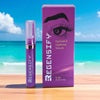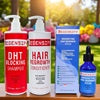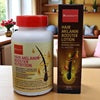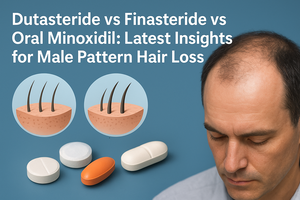WELCOME TO REGENSIFY
WELCOME TO REGENSIFY
Products
REGENSIFY Bodycare Collection

REJUVENATE YOUR BODY WITH REGENSIFY
REGENSIFY Eyecare Collection

REDENSIFY YOUR LASHES AND BROWS WITH REGENSIFY
REGENSIFY Haircare Collection

REDENSIFY YOUR HAIR WITH REGENSIFY

REVERSE GREY HAIR WITH REGENSIFY
Bundles
Dutasteride vs Finasteride vs Oral Minoxidil: Latest Insights for Male Pattern Hair Loss
October 07, 2025 4 min read

Androgenetic alopecia (male pattern hair loss) is one of the most common causes of hair thinning in men. While topical minoxidil and oral finasteride are long-standing FDA-approved treatments, people are exploring alternative oral medication such as Oral Dutasteride and Oral Minoxidil. In this blog, we will explore two studies.
The first study is a 2022 clinical study paper published by Gupta, Talukder, and Williams, which directly compares oral minoxidil, oral finasteride and oral dutasteride on male pattern hair loss.
The second study is a 2025 clinical study published by Abhishek Kumar Jha, Shreeparna Deb, Vikas Shankar, Ramawatar Singh, which compares the results of Low Dose Dutasteride + Low Dose Minoxidil vs Low Dose Dutasteride alone.
To keep this blog post within the main focus, we will not go too much details of the side effects of oral finasteride, oral minoxidil and oral dutasteride here in this blog. Dutasteride is a more potent drug than Finasteride because Finasteride blocks only Type 2 5-alpha reductase enzymes whereas Dutasteride blocks both Type 1 and Type 2 5-alpha Reductase enzymes. This dual-inhibition by dutasteride leads to a more complete and consistent reduction in dihydrotestosterone (DHT) levels compared to finasteride. Dutasteride may have a weak or minimal inhibition on Type 3 5-alpha reductase enzymes but it is not clinically significant compared to its strong activity against Type I and II.
Study 1: Oral Minoxidil vs. Finasteride vs. Dutasteride
A 2022 review by Gupta, Talukder, and Williams directly compared oral minoxidil, finasteride, and dutasteride for male pattern baldness.
-
Dutasteride proved the most effective at blocking DHT (dihydrotestosterone) and showed stronger hair regrowth compared to finasteride.
-
Finasteride remained a reliable, clinically established option with a strong safety record.
-
Oral minoxidil, though traditionally used topically, showed promising results as a standalone alternative, especially for men who don’t respond well to Topical Minxoidil.

Comparison of Finasteride vs. Dutasteride Effects
| Category | Finasteride (5 mg/day, 24 weeks) | Dutasteride (0.5 mg/day, 24 weeks) | Key Point |
|---|---|---|---|
| 1. 5α-Reductase Inhibition | Selective for Type II (prostate, hair follicle, testes, liver) | Inhibits Type I, II, and weakly III (broader tissue distribution) | Dutasteride blocks more 5-alpha reductase enzymes → stronger effect |
| 2. DHT Suppression | Serum: 73% ↓ Scalp: 41% ↓ |
Serum: 92% ↓ Scalp: 51% ↓ |
Dutasteride reduces DHT more effectively in both serum and scalp |
| 3. Testosterone Increase | Serum: +10% Scalp: +23% |
Serum: +24% Scalp: +99% |
Dutasteride causes a much larger scalp testosterone increase |

Based on the results, 0.5 mg/day of Dutasteride has the best efficacy, followed by 5 mg of oral Finasteride, then 5 mg of oral Minoxidil, 1 mg of Finasteride and lastly, 0.25 mg of Oral Minxoidil. The study is interesting because for healthy men with no cardiac issues and are worried about the side effects of oral finasteride, they may consider taking 5 mg of oral Minoxidil. You may also want to watch Dr Dray's video below as her video gave a very good summary and analysis of the clinical study published by Gupta, Talukder, and Williams.
Hair Loss Treatment Ranked - Video By Dr Dray from USA
Study 2: Dutasteride Alone vs. Dutasteride + Oral Minoxidil
In a prospective clinical study published by Abhishek Kumar Jha, Shreeparna Deb, Vikas Shankar, Ramawatar Singh in 2025, researchers tested whether combining low-dose oral dutasteride with low-dose oral minoxidil produced better outcomes than dutasteride alone.
-
Both groups saw improvement in hair growth, but the combination therapy achieved significantly higher hair density and regrowth.
-
The two medications work through different mechanisms: dutasteride reduces DHT, while minoxidil improves follicle blood supply and prolongs the growth phase.
-
Side effects were minimal at low doses, making the combination a potentially safer and more powerful strategy for treating androgenetic alopecia.
Results from Study 2


Key Takeaways for Hair Loss Treatment
-
Dutasteride is currently the strongest single oral medication for androgenetic alopecia in men.
-
Oral minoxidil is emerging as a viable alternative or add-on therapy, especially for those who does not respond well to Topical Minoxidil.
-
Combination therapy (dutasteride + oral minoxidil) may deliver superior results, especially for men who want more noticeable regrowth. This result is not surprising considering that Topical Minoxidil + Oral Finasteride produce better results than Topical Minoxidil or Oral Finasteride alone.
-
Treatment should always be individualized, balancing efficacy, side effects, and patient preferences.
- Do note that clinical studies are conducted on men from Norwood II to Norwood IV. Beyond a certain age, a certain number of years of hair loss history and having Norwood 5 and above, oral medications, including the most efficacious 0.5 mg of duasteride can only help maintain the hair rather than regrow new hairs. In this case, seeing a hair doctor for hair transplant or regenerative treatments via injections are necessary for hair regrowth.
Do note that it is recommended to see doctor for medical advise before taking oral finasteride, oral minoxidil or oral dutasteride. Not everyone is suitable to take oral finasteride, oral minoxidil or oral dutasteride. You should not go straight to take oral dutasteride until you have tried out oral finasteride.
Feel free to download the two published papers from the two links below.
DOWNLOAD Comparison of oral minoxidil, finasteride and dutasteride for treating androgenetic alopecia
Disclaimer: All brand names and trademarks mentioned are the property of their respective owners. This article is intended for educational and informational purposes only, based on publicly available data and clinical studies.
Leave a comment
Recent Articles
-
Dutasteride vs Finasteride vs Oral Minoxidil: Latest Insights for Male Pattern Hair Loss
October 07, 2025
-
Kordel's vs REGENSIFY vs Trichoderm: The Ultimate Melatine Supplement
September 24, 2025
-
Battle of the Anti-Grey Titans: REGENSIFY Lotion vs Trichoderm Serum
September 22, 2025
-
Melatine®: The Black Sheep Secret to Fighting Grey Hair Naturally
September 20, 2025
-
The Ultimate Anti-Grey Trio: Greyverse + Darkenyl + MelanoGray. Repair, Fuel and Protect.
September 19, 2025
-
Darkenyl + MelanoGray: Double Defense Against Grey Hairs
September 16, 2025
-
Tyrosine and Grey Hair — Oral vs Topical Solutions
September 15, 2025
-
Hair Growth vs Hair Colour: Can Minoxidil Trigger Premature Greying? A new study suggests the answer is a YES.
September 13, 2025
-
Synergy: Adenosine and Coenzyme Q10: How They Help Prevent Grey Hair
September 10, 2025
-
REGENSIFY VS VIDA GLOW - Which AnaGain™ Nu formula works best to prevent hair loss?
September 01, 2025
Latest REGENSIFY Blog Posts
Share this product

Dutasteride vs Finasteride vs Oral Minoxidil: Latest Insights for Male
2022 research compares oral dutasteride, finasteride & minoxidil. 2025 hair loss study shows dutasteride plus oral minoxidil outperforms dutasteride alone.
































